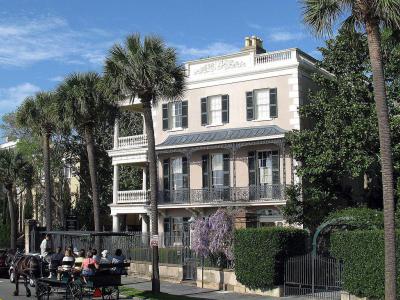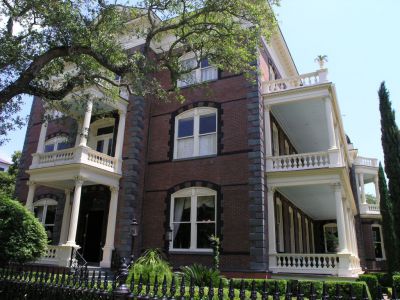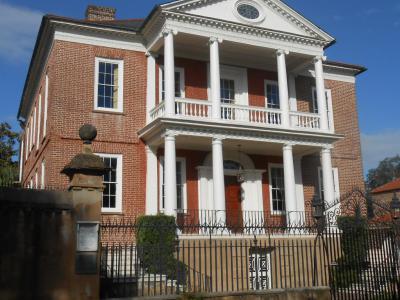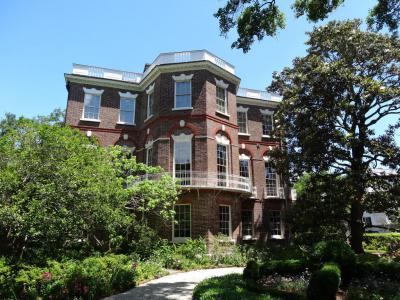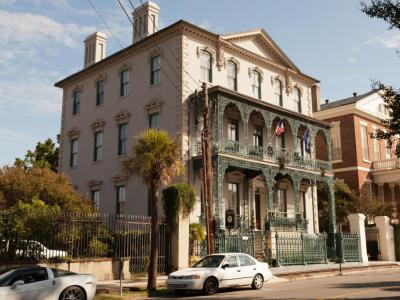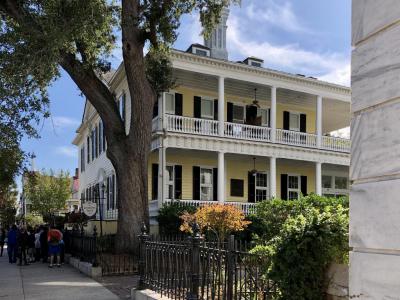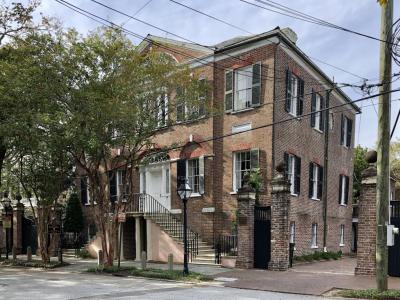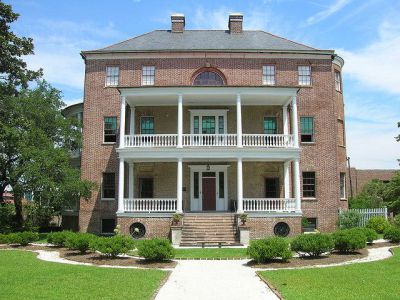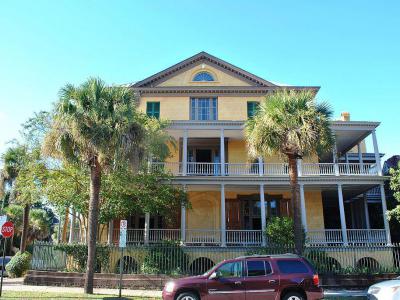
Historical Houses Tour (Self Guided), Charleston
Charleston is steeped in history. Walking the colorful, narrow cobblestone streets of one of America's oldest towns, with its stunningly preserved colonial homes, you can see its story play out before your eyes practically everywhere you turn. Indeed, Charleston is among the most celebrated places in the U.S. to explore fine examples of American architecture and its progression through time.
A veritable architectural museum without walls, the city is home to over 2,800 historic buildings designed in an array of period styles, such as Colonial, Georgian, Regency, Federal, Adamesque, Classical Revival, Greek Revival, Gothic Revival, Italianate, Queen Anne, Victorian and Art Deco, all playing witness to its eventful past.
If you wish to marvel at the extravagance and opulence of the pre-Civil War era in the South, here are some of the best-known edifices not to be missed:
Nathaniel Russell House – constructed at the turn of the 19th century, this historic home is known for its spiraling staircase, detailed furnishings and landscaped gardens;
Heyward-Washington House – a Georgian-style dwelling of Thomas Heyward, Jr., who signed the Declaration of Independence;
John Rutledge House – a luxurious Bed-and-Breakfast with 12-foot high ceilings and Italian marble gas fireplaces, among other amenities, whose ethereal beauty emanates the elegance of a bygone era;
Aiken-Rhett House – one of the most famous Federal-style buildings in Charleston and a unique educational place to learn about the ways of the city's life in the early 1800s;
The best way for visitors to explore Charleston's architectural history is by foot with a knowledgeable tour guide. Although you can now easily do it on your own, thanks to the GPSmyCity mobile app. To see how, take this self-guided walk.
A veritable architectural museum without walls, the city is home to over 2,800 historic buildings designed in an array of period styles, such as Colonial, Georgian, Regency, Federal, Adamesque, Classical Revival, Greek Revival, Gothic Revival, Italianate, Queen Anne, Victorian and Art Deco, all playing witness to its eventful past.
If you wish to marvel at the extravagance and opulence of the pre-Civil War era in the South, here are some of the best-known edifices not to be missed:
Nathaniel Russell House – constructed at the turn of the 19th century, this historic home is known for its spiraling staircase, detailed furnishings and landscaped gardens;
Heyward-Washington House – a Georgian-style dwelling of Thomas Heyward, Jr., who signed the Declaration of Independence;
John Rutledge House – a luxurious Bed-and-Breakfast with 12-foot high ceilings and Italian marble gas fireplaces, among other amenities, whose ethereal beauty emanates the elegance of a bygone era;
Aiken-Rhett House – one of the most famous Federal-style buildings in Charleston and a unique educational place to learn about the ways of the city's life in the early 1800s;
The best way for visitors to explore Charleston's architectural history is by foot with a knowledgeable tour guide. Although you can now easily do it on your own, thanks to the GPSmyCity mobile app. To see how, take this self-guided walk.
How it works: Download the app "GPSmyCity: Walks in 1K+ Cities" from Apple App Store or Google Play Store to your mobile phone or tablet. The app turns your mobile device into a personal tour guide and its built-in GPS navigation functions guide you from one tour stop to next. The app works offline, so no data plan is needed when traveling abroad.
Historical Houses Tour Map
Guide Name: Historical Houses Tour
Guide Location: USA » Charleston (See other walking tours in Charleston)
Guide Type: Self-guided Walking Tour (Sightseeing)
# of Attractions: 10
Tour Duration: 2 Hour(s)
Travel Distance: 4.3 Km or 2.7 Miles
Author: alice
Sight(s) Featured in This Guide:
Guide Location: USA » Charleston (See other walking tours in Charleston)
Guide Type: Self-guided Walking Tour (Sightseeing)
# of Attractions: 10
Tour Duration: 2 Hour(s)
Travel Distance: 4.3 Km or 2.7 Miles
Author: alice
Sight(s) Featured in This Guide:
- Edmondston-Alston House
- Williams Mansion (fka Calhoun Mansion)
- Miles Brewton House
- Nathaniel Russell House
- Heyward-Washington House
- John Rutledge House Inn
- Edward Rutledge House (Governor's House Inn)
- William Blacklock House
- Joseph Manigault House
- Aiken-Rhett House Museum
1) Edmondston-Alston House (must see)
In 1825, Charles Edmondston, a wealthy merchant and wharf owner, constructed this impressive three-story residence (originally of English Regency style) where he could enjoy unobstructed views of Charleston Harbor. The front staircase led to two drawing rooms on the second floor, with smaller rooms behind them serving as withdrawing spaces—one for ladies and one for gentlemen. The house featured 14-foot-high ceilings, large window and door openings for better airflow during the summer, and a library room. Additionally, the property featured a kitchen, servants' quarters, horse stables, and carriage facilities.
However, economic hardships stemming from the Panic of 1837 led Edmondston to sell the house to Charles Alston, a member of a prominent Low Country rice-planting family. Alston promptly renovated the architecture in the fashionable Greek Revival style. Additions included a third-story piazza with Corinthian columns, a cast-iron balcony across the front, and a rooftop railing displaying the Alston coat of arms. The Alstons received their visitors on the first floor, while social gatherings were held on the second floor.
Remarkably, many family documents, portraits, silver items, and fine furnishings from the 1830s, including Charles Alston's nearly intact library, can still be found today. Known for its unique Regency woodwork and uncompromising views of the harbor, the house's intimate atmosphere and authentic details may make visitors feel as though the Alstons only recently departed, perhaps for a countryside visit.
However, economic hardships stemming from the Panic of 1837 led Edmondston to sell the house to Charles Alston, a member of a prominent Low Country rice-planting family. Alston promptly renovated the architecture in the fashionable Greek Revival style. Additions included a third-story piazza with Corinthian columns, a cast-iron balcony across the front, and a rooftop railing displaying the Alston coat of arms. The Alstons received their visitors on the first floor, while social gatherings were held on the second floor.
Remarkably, many family documents, portraits, silver items, and fine furnishings from the 1830s, including Charles Alston's nearly intact library, can still be found today. Known for its unique Regency woodwork and uncompromising views of the harbor, the house's intimate atmosphere and authentic details may make visitors feel as though the Alstons only recently departed, perhaps for a countryside visit.
2) Williams Mansion (fka Calhoun Mansion) (must see)
This house museum stands out as one of Charleston's few grand Victorian-era palaces; a remarkable example of the Italianate style that gained popularity in America during the latter half of the 19th century. In Charleston's diverse architectural landscape, this style is somewhat rare, possibly because it emerged at a time when the city was still grappling with the economic aftermath of the Civil War. During the postwar Reconstruction period, there was limited construction of grand mansions in Charleston; however, George Walton Williams, a wholesale grocer and banker, was undeterred by the city's economic challenges. Unlike many wealthy Southerners, he had made substantial investments in England and the North before the war.
Upon its completion in 1876, the grand Charleston residence garnered extravagant praise in newspapers from New York, Atlanta, and Charleston, which all touted it as "the handsomest and most-complete home in the South, if not the country." To this day, it remains Charleston's largest privately owned home, with its 35 rooms, 24,000 square feet of living space, 23 fireplaces, a three-tiered piazza, Italian water gardens adorned with fountains, and a towering cupola that rises 90 feet above Charleston Harbor.
The name "Calhoun" is associated with the house because Williams's son-in-law, Patrick Calhoun (grandson of John C. Calhoun, known as "The Great Nullifier"), resided here until 1929, when he lost the house and his fortune in the stock market crash. Subsequent owners struggled to find a suitable use for the historic mansion, leading to its gradual decline and eventual condemnation in the 1970s. However, a young local attorney acquired the property and spent a considerable fortune and 25 years restoring its structural and artistic grandeur.
Today, the mansion showcases the extensive personal collection of the new owner, featuring English and American furniture from the 18th and 19th centuries, with a focus on Southern decorative arts. There's also an impressive collection of impressionist art, Chinese ceramics, and various art objects that seamlessly blend with the Victorian-era ambiance originally designed to create an impressive display. The mansion has gained national recognition, appearing in numerous magazines and serving as a set for the notable television miniseries "North and South". While photography is not permitted inside, visitors can enjoy a 35-minute tour that provides informative insights into the mansion's history and significance. The grounds also offer charming garden spaces adorned with statues and fountains.
Upon its completion in 1876, the grand Charleston residence garnered extravagant praise in newspapers from New York, Atlanta, and Charleston, which all touted it as "the handsomest and most-complete home in the South, if not the country." To this day, it remains Charleston's largest privately owned home, with its 35 rooms, 24,000 square feet of living space, 23 fireplaces, a three-tiered piazza, Italian water gardens adorned with fountains, and a towering cupola that rises 90 feet above Charleston Harbor.
The name "Calhoun" is associated with the house because Williams's son-in-law, Patrick Calhoun (grandson of John C. Calhoun, known as "The Great Nullifier"), resided here until 1929, when he lost the house and his fortune in the stock market crash. Subsequent owners struggled to find a suitable use for the historic mansion, leading to its gradual decline and eventual condemnation in the 1970s. However, a young local attorney acquired the property and spent a considerable fortune and 25 years restoring its structural and artistic grandeur.
Today, the mansion showcases the extensive personal collection of the new owner, featuring English and American furniture from the 18th and 19th centuries, with a focus on Southern decorative arts. There's also an impressive collection of impressionist art, Chinese ceramics, and various art objects that seamlessly blend with the Victorian-era ambiance originally designed to create an impressive display. The mansion has gained national recognition, appearing in numerous magazines and serving as a set for the notable television miniseries "North and South". While photography is not permitted inside, visitors can enjoy a 35-minute tour that provides informative insights into the mansion's history and significance. The grounds also offer charming garden spaces adorned with statues and fountains.
3) Miles Brewton House
A short hop away from the Nathaniel Russell House, this double house dating back to the 1760s (named for its layout with four main rooms per floor, divided by a central stair hall) was constructed for Miles Brewton, a prosperous slave trader and planter. It's often hailed as one of the finest examples of Georgian-Palladian architecture globally. The striking medieval-looking wrought-iron fencing, known as 'chevaux-de-frise', was added much later, in the 1820s, in response to rumors of a potential slave uprising circulating through town.
This grand property, now a private residence, was the site of not one but two headquarters of occupying armies: that of British general Henry Clinton during the Revolution, and later, the federal garrison following the end of the Civil War. Located on a two-acre plot, its extensive collection of ancillary structures makes it one of the most complete Georgian townhouse complexes in the United States.
On the northern side of the house lies a so-called "plantation lane", where you'll find the property's various outbuildings. These include historically accurate slave quarters, a kitchen, and a pavilion, all connected by a covered arcade. The sizable garden area directly behind the house still retains its original 18th-century layout.
This grand property, now a private residence, was the site of not one but two headquarters of occupying armies: that of British general Henry Clinton during the Revolution, and later, the federal garrison following the end of the Civil War. Located on a two-acre plot, its extensive collection of ancillary structures makes it one of the most complete Georgian townhouse complexes in the United States.
On the northern side of the house lies a so-called "plantation lane", where you'll find the property's various outbuildings. These include historically accurate slave quarters, a kitchen, and a pavilion, all connected by a covered arcade. The sizable garden area directly behind the house still retains its original 18th-century layout.
4) Nathaniel Russell House (must see)
Nathaniel Russell, a prominent shipping merchant, chose to erect his grand "mansionhouse" on Meeting Street, strategically located within view of the busy wharves that fueled his prosperity. In 1808, at the age of 71, Russell's opulent residence was completed, at a reported cost of $80,000—an astronomical sum for its time. Inspired by the architectural style of English designer Robert Adam, who drew influence from the recently unearthed classical designs discovered in the Italian excavations of Pompeii and Herculaneum, Russell's new abode showcased a blend of elegance and classical influence.
Visitors today are immediately captivated by the breathtaking elliptical staircase, seemingly floating through three floors without any apparent support, set against a backdrop of golden walls in the stair hall. The Adamesque embellishments adorning the mantels and cornices of the fireplaces here also rank among the most intricate in the city.
Elegantly proportioned rooms exhibit a splendid array of Charleston, English, and French furnishings, including precious china, silver, and paintings. The oval drawing room on the second floor stands out as the most lavishly adorned space, and served as the retreat for women after dinner. Draped in an apricot palette, it features ornate plaster moldings coated with 24-karat gold leaf.
Unlike most other Charleston house museums, the Russell House has never been through a sad period of decline and disrepair. First as a fine town house, then as the home of a South Carolina governor, and later as a school for girls and even a convent, 51 Meeting Street has always been a respected and cared-for landmark. Today it is owned and operated by Historic Charleston Foundation, an organization that has done much to preserve and illuminate the city's architectural heritage.
To the south of the house lies a formal English garden with gravel paths, boxwood hedges, and 19th-century botanical favorites. At the rear, you'll find the two-story slave quarters that once accommodated the 18 enslaved individuals who lived and worked on the property.
Tip:
It's a good idea to arrive early, especially if you're planning a weekend tour. Online tickets don't come with specific time slots, and on-site tours are assigned on a first-come-first-served basis. While you're in the area, consider exploring the nearby old graveyard before or after your visit to the house. If you're interested, you can also opt for an additional fee to access the sister Aiken-Rhett House, farther uptown.
Visitors today are immediately captivated by the breathtaking elliptical staircase, seemingly floating through three floors without any apparent support, set against a backdrop of golden walls in the stair hall. The Adamesque embellishments adorning the mantels and cornices of the fireplaces here also rank among the most intricate in the city.
Elegantly proportioned rooms exhibit a splendid array of Charleston, English, and French furnishings, including precious china, silver, and paintings. The oval drawing room on the second floor stands out as the most lavishly adorned space, and served as the retreat for women after dinner. Draped in an apricot palette, it features ornate plaster moldings coated with 24-karat gold leaf.
Unlike most other Charleston house museums, the Russell House has never been through a sad period of decline and disrepair. First as a fine town house, then as the home of a South Carolina governor, and later as a school for girls and even a convent, 51 Meeting Street has always been a respected and cared-for landmark. Today it is owned and operated by Historic Charleston Foundation, an organization that has done much to preserve and illuminate the city's architectural heritage.
To the south of the house lies a formal English garden with gravel paths, boxwood hedges, and 19th-century botanical favorites. At the rear, you'll find the two-story slave quarters that once accommodated the 18 enslaved individuals who lived and worked on the property.
Tip:
It's a good idea to arrive early, especially if you're planning a weekend tour. Online tickets don't come with specific time slots, and on-site tours are assigned on a first-come-first-served basis. While you're in the area, consider exploring the nearby old graveyard before or after your visit to the house. If you're interested, you can also opt for an additional fee to access the sister Aiken-Rhett House, farther uptown.
5) Heyward-Washington House (must see)
This early Charleston "dwelling house" is known by two names, thanks to the two notable Americans associated with it: one, the owner, and the other, a distinguished guest. Constructed in 1772 by Daniel Heyward, a prosperous rice planter and the father of Thomas Heyward Jr., a South Carolina signer of the Declaration of Independence (who resided in the house until 1794), the house has a rich history.
In 1791, President George Washington embarked on a grand tour of the fledgling nation, which included a stop in Charleston. In anticipation of the President's visit, the city arranged to rent Heyward's house for Washington's accommodations, temporarily displacing Heyward to his country house. In his diary, Washington recorded his visit to the property, stating: "The lodgings provided for me in this place were very good, being the furnished house of a gentleman at present residing in the country; but occupied by a person placed there on purpose to accommodate me."
Today, the house is beautifully furnished with a remarkable collection of period antiques, including exquisite 18th-century Charleston-made furniture. A highlight is the priceless 1770 Chippendale-style Holmes bookcase, hailed by BBC Antiques Roadshow experts as the "finest example of American-made furniture", still bearing the marks of a British mortar strike from the American Revolution days.
Notably, this is the only 18th-century house museum in the city that retains its original outbuildings, such as the carriage shed and the 1740s kitchen building. You'll also discover a quaint formal garden, showcasing plants commonly cultivated in the South Carolina Lowcountry during the late 18th century.
Why You Should Visit:
Knowledgeable guides will point you in all the right directions, allowing you to admire the amazing craftsmanship of furniture makers and the second-floor ballroom—a delightful surprise to many, offering a glimpse into the country's early days. Not to mention that standing in the very room where George Washington stayed is an unforgettable experience!
Tip:
Consider looking into the Charleston Heritage Passport, which grants access to 5 houses, 2 museums, and 2 plantations. You can acquire it at the Visitors Center on John Street.
In 1791, President George Washington embarked on a grand tour of the fledgling nation, which included a stop in Charleston. In anticipation of the President's visit, the city arranged to rent Heyward's house for Washington's accommodations, temporarily displacing Heyward to his country house. In his diary, Washington recorded his visit to the property, stating: "The lodgings provided for me in this place were very good, being the furnished house of a gentleman at present residing in the country; but occupied by a person placed there on purpose to accommodate me."
Today, the house is beautifully furnished with a remarkable collection of period antiques, including exquisite 18th-century Charleston-made furniture. A highlight is the priceless 1770 Chippendale-style Holmes bookcase, hailed by BBC Antiques Roadshow experts as the "finest example of American-made furniture", still bearing the marks of a British mortar strike from the American Revolution days.
Notably, this is the only 18th-century house museum in the city that retains its original outbuildings, such as the carriage shed and the 1740s kitchen building. You'll also discover a quaint formal garden, showcasing plants commonly cultivated in the South Carolina Lowcountry during the late 18th century.
Why You Should Visit:
Knowledgeable guides will point you in all the right directions, allowing you to admire the amazing craftsmanship of furniture makers and the second-floor ballroom—a delightful surprise to many, offering a glimpse into the country's early days. Not to mention that standing in the very room where George Washington stayed is an unforgettable experience!
Tip:
Consider looking into the Charleston Heritage Passport, which grants access to 5 houses, 2 museums, and 2 plantations. You can acquire it at the Visitors Center on John Street.
6) John Rutledge House Inn
Sitting on the north side of Broad Street in the historic center of Charleston, the John Rutledge House Inn is close to the old South of Broad neighborhood not only in terms of location but also in terms of feel. Renowned as "America's most historic inn", this house boasts a fine old pedigree. Constructed in the 1760s for the Constitution signer John Rutledge, it is one of just fifteen residences belonging to the original signatories that have endured the test of time. Even George Washington himself enjoyed breakfast within its walls, joining a long list of patriots, statesmen, and presidents who came to visit Mr. Rutledge.
Today, the towering three-story structure stands as one of Charleston's most sought-after bed-and-breakfasts, holding a prestigious AAA Four-Diamond rating. While the building has been modernized to incorporate all modern conveniences and is furnished with elegant yet exceptionally comfortable furniture, history still permeates every nook and cranny here. Overall, there are 19 guest rooms, ranging in size from standard to spacious, inside the main house and two carriage houses at the rear of the property. The interior is a showcase of period splendor, featuring Italian marble fireplaces, original plaster moldings, and exquisite ironwork in the public areas. The ballroom, open to the public, serves as a delightful venue for afternoon tea and breakfast.
Today, the towering three-story structure stands as one of Charleston's most sought-after bed-and-breakfasts, holding a prestigious AAA Four-Diamond rating. While the building has been modernized to incorporate all modern conveniences and is furnished with elegant yet exceptionally comfortable furniture, history still permeates every nook and cranny here. Overall, there are 19 guest rooms, ranging in size from standard to spacious, inside the main house and two carriage houses at the rear of the property. The interior is a showcase of period splendor, featuring Italian marble fireplaces, original plaster moldings, and exquisite ironwork in the public areas. The ballroom, open to the public, serves as a delightful venue for afternoon tea and breakfast.
7) Edward Rutledge House (Governor's House Inn)
Constructed in 1760 by John Laurens, this is Charleston's oldest house currently functioning as a bed-and-breakfast. It is the former residence of Edward Rutledge, the younger brother of John Rutledge and the youngest signer of the Declaration of Independence, who also served as the governor of South Carolina from 1798 to 1800. Trained in law in England, Rutledge established his legal practice in Charleston before becoming involved in the First and Second Continental Congresses. During the American Revolutionary War, he was taken prisoner after being captured during the 1780 Siege of Charleston.
Today, this property is a National Historic Landmark, featuring 11 beautifully decorated guest rooms. The Laurens room offers picturesque views of the historic architecture in the area, while the Jefferson Suite features a separate living room, private porch, wet bar, and an original 1760 fireplace. Guests can enjoy a Southern gourmet breakfast as well as afternoon tea and evening sherry. The location is ideal, situated on the periphery of the original Grand Modell city and the prestigious Below Broad residential area. Additionally, it's within convenient walking distance of King Street's shopping and antiques district.
Today, this property is a National Historic Landmark, featuring 11 beautifully decorated guest rooms. The Laurens room offers picturesque views of the historic architecture in the area, while the Jefferson Suite features a separate living room, private porch, wet bar, and an original 1760 fireplace. Guests can enjoy a Southern gourmet breakfast as well as afternoon tea and evening sherry. The location is ideal, situated on the periphery of the original Grand Modell city and the prestigious Below Broad residential area. Additionally, it's within convenient walking distance of King Street's shopping and antiques district.
8) William Blacklock House
Built in 1800 for William Blacklock, a prominent British merchant and a member of Charleston's Bank of the United States, this house is not only one of the most significant Adamesque residences in the country but also one of the earliest permanent homes in the Harleston Village, which was once considered a suburban retreat. In the early 19th century, properties located to the north of the old city offered residents a more secluded atmosphere compared to the bustling downtown area, contrary to the density surrounding the house today.
While the architect remains unknown, rumors suggest that it was either William Drayton or Gabriel Manigault, the latter being Charleston's renowned gentleman architect.
Symmetrical in both plan and elevation, the building reveals Palladian proportions and the high-style Federal aesthetic of the era. Architectural elements include a frieze with a rosette motif, swags, dentils, and block modillions characteristic of the Federal style. The north façade highlights a Palladian window centered within the façade, while a porch on the north side connects to a recently added free-standing elevator tower. Furthermore, the structure is adorned with intricate motifs such as egg and dart, bead and reel, dentils, swags, cherubs, vases, and fluttering ribbons on mantels and surrounds, showcasing the high-style mannerisms of the era's architecture.
The property additionally includes two outbuildings, each showing Gothic Revival features.
The Blacklock House underwent a major restoration in 1937 and received recognition as a National Historic Landmark in 1973 for its design and architectural significance. Acquired by the College of Charleston a year later, it now houses its Office of Alumni Relations.
While the architect remains unknown, rumors suggest that it was either William Drayton or Gabriel Manigault, the latter being Charleston's renowned gentleman architect.
Symmetrical in both plan and elevation, the building reveals Palladian proportions and the high-style Federal aesthetic of the era. Architectural elements include a frieze with a rosette motif, swags, dentils, and block modillions characteristic of the Federal style. The north façade highlights a Palladian window centered within the façade, while a porch on the north side connects to a recently added free-standing elevator tower. Furthermore, the structure is adorned with intricate motifs such as egg and dart, bead and reel, dentils, swags, cherubs, vases, and fluttering ribbons on mantels and surrounds, showcasing the high-style mannerisms of the era's architecture.
The property additionally includes two outbuildings, each showing Gothic Revival features.
The Blacklock House underwent a major restoration in 1937 and received recognition as a National Historic Landmark in 1973 for its design and architectural significance. Acquired by the College of Charleston a year later, it now houses its Office of Alumni Relations.
9) Joseph Manigault House (must see)
The Manigault House, designed and constructed in 1803 by Charleston architect Gabriel Manigault for his brother Joseph, is a striking example of the elegant Adam style that dominated Charleston's architecture during the early 19th century. Both Manigault brothers, wealthy rice planters, had refined tastes influenced by their travels and education. Gabriel, who had studied in Geneva and London, maintained an extensive architectural library, and the house reflects his sophisticated architectural sensibilities.
This remarkable edifice features one of the most graceful staircases in Charleston and showcases an exceptional collection of period furniture from Charleston, America, England, and France. Additionally, the gatehouse near the entrance serves as a fascinating conversation piece, exemplifying the trend of wealthy homeowners striving to outdo their neighbors.
As a whole, the structure and its gatehouse have been initially considered an architectural folly. A bigger folly, however, almost occurred in 1920 when it was threatened with demolition to make way for a gas station. Fortunately, a preservation group, which later became the Preservation Society of Charleston, successfully prevented its destruction.
The 45-minute tour of the interior is enlightening as it explains why the house was built the way it was; as a plus, you'll get to see the delicately refined woodwork in the fireplace mantels, door and window moldings, and cornices, reflective of the style promoted by Robert Adam, which differentiated the scale of these elements in domestic and civic architecture.
Why You Should Visit:
This is where you go if you are an architecture fan, not an artifact lover. The fine detail in this house will delight and amaze!
This remarkable edifice features one of the most graceful staircases in Charleston and showcases an exceptional collection of period furniture from Charleston, America, England, and France. Additionally, the gatehouse near the entrance serves as a fascinating conversation piece, exemplifying the trend of wealthy homeowners striving to outdo their neighbors.
As a whole, the structure and its gatehouse have been initially considered an architectural folly. A bigger folly, however, almost occurred in 1920 when it was threatened with demolition to make way for a gas station. Fortunately, a preservation group, which later became the Preservation Society of Charleston, successfully prevented its destruction.
The 45-minute tour of the interior is enlightening as it explains why the house was built the way it was; as a plus, you'll get to see the delicately refined woodwork in the fireplace mantels, door and window moldings, and cornices, reflective of the style promoted by Robert Adam, which differentiated the scale of these elements in domestic and civic architecture.
Why You Should Visit:
This is where you go if you are an architecture fan, not an artifact lover. The fine detail in this house will delight and amaze!
10) Aiken-Rhett House Museum (must see)
The Aiken-Rhett House stands out from other house museums, offering a captivating glimpse into the history and tastes of antebellum Charleston. Originally built in 1818 as a typical single house, it underwent significant transformations during the ownership of South Carolina's Governor William Aiken. Aiken, who resided here from 1833 to 1887, remodeled the house twice, first embracing the bold Greek Revival style in 1833 and then adopting the ornate Rococo Revival style in 1857.
What makes this building truly unique is its well-preserved, rather than restored, state. Much of the furnishings and personal belongings of Governor and Mrs. Aiken, including portraits, statuary, library volumes, and exquisite chandeliers from their European travels, remain in place. The interior provides an almost eerie sense of stepping back in time, where you can imagine historical figures like Jefferson Davis and Confederate General P. G. T. Beauregard as guests during pivotal moments of the Civil War.
One of the property's most striking features is its remarkably preserved slave quarters and outbuildings, providing a sobering glimpse into the realities of slavery and 19th-century Southern society. The contrast between the ornate horse stalls and the utilitarian slave quarters underscores the stark inequalities of the time.
Why You Should Visit:
The house's preservation rather than restoration offers a real sense of the lives of indentured individuals, the privileged world of the residents, and the impact of time, with the audio guide providing concise but informative context and details about daily life.
Tip:
Visit earlier in the day as it can get quite hot inside. You can borrow a handheld fan at the ticket desk if necessary.
What makes this building truly unique is its well-preserved, rather than restored, state. Much of the furnishings and personal belongings of Governor and Mrs. Aiken, including portraits, statuary, library volumes, and exquisite chandeliers from their European travels, remain in place. The interior provides an almost eerie sense of stepping back in time, where you can imagine historical figures like Jefferson Davis and Confederate General P. G. T. Beauregard as guests during pivotal moments of the Civil War.
One of the property's most striking features is its remarkably preserved slave quarters and outbuildings, providing a sobering glimpse into the realities of slavery and 19th-century Southern society. The contrast between the ornate horse stalls and the utilitarian slave quarters underscores the stark inequalities of the time.
Why You Should Visit:
The house's preservation rather than restoration offers a real sense of the lives of indentured individuals, the privileged world of the residents, and the impact of time, with the audio guide providing concise but informative context and details about daily life.
Tip:
Visit earlier in the day as it can get quite hot inside. You can borrow a handheld fan at the ticket desk if necessary.
Walking Tours in Charleston, South Carolina
Create Your Own Walk in Charleston
Creating your own self-guided walk in Charleston is easy and fun. Choose the city attractions that you want to see and a walk route map will be created just for you. You can even set your hotel as the start point of the walk.
Downtown Historical Churches Tour
Charleston, South Carolina, is also sometimes called the “Holy City.” This is due to the large number of churches found here. Needless to say, the most fascinating of them are concentrated in the Downtown area, each with its unique charm and significance.
Among such temples of distinction is Saint Matthew's Church, an enduring symbol of Charleston's German Lutheran community. Its... view more
Tour Duration: 1 Hour(s)
Travel Distance: 1.3 Km or 0.8 Miles
Among such temples of distinction is Saint Matthew's Church, an enduring symbol of Charleston's German Lutheran community. Its... view more
Tour Duration: 1 Hour(s)
Travel Distance: 1.3 Km or 0.8 Miles
Harleston Village Walking Tour
Founded in the 18th century, the historic Harleston Village is a charming neighborhood in Charleston, South Carolina. The rich past and vibrant present of this area make it a popular destination for tourists.
At the heart of Harleston Village lies the College of Charleston, an esteemed institution of higher learning, established in 1770, adding a great deal of academic flair to the... view more
Tour Duration: 2 Hour(s)
Travel Distance: 2.3 Km or 1.4 Miles
At the heart of Harleston Village lies the College of Charleston, an esteemed institution of higher learning, established in 1770, adding a great deal of academic flair to the... view more
Tour Duration: 2 Hour(s)
Travel Distance: 2.3 Km or 1.4 Miles
Charleston Introduction Walking Tour
A popular tourist destination and a major port city in South Carolina, Charleston is fit to impress anyone with its Southern charm, friendliness, and rich history. Founded in 1670 as Charles Town, honoring King Charles II of England, this was the first comprehensively planned town in America.
The city's significance in American history is tied to its role as a key slave trading port. The... view more
Tour Duration: 2 Hour(s)
Travel Distance: 2.8 Km or 1.7 Miles
The city's significance in American history is tied to its role as a key slave trading port. The... view more
Tour Duration: 2 Hour(s)
Travel Distance: 2.8 Km or 1.7 Miles
French Quarter Walking Tour
A historic district in downtown Charleston, The French Quarter is named so for the high concentration of French merchants that once lived in the area and left their mark on it. The name was coined in 1973, when preservation efforts began for warehouse buildings on the Lodge Alley block. That same year the district was added to the National Register of Historic Places.
The busy neighbourhood... view more
Tour Duration: 1 Hour(s)
Travel Distance: 1.6 Km or 1 Miles
The busy neighbourhood... view more
Tour Duration: 1 Hour(s)
Travel Distance: 1.6 Km or 1 Miles
The Most Popular Cities
/ view all
